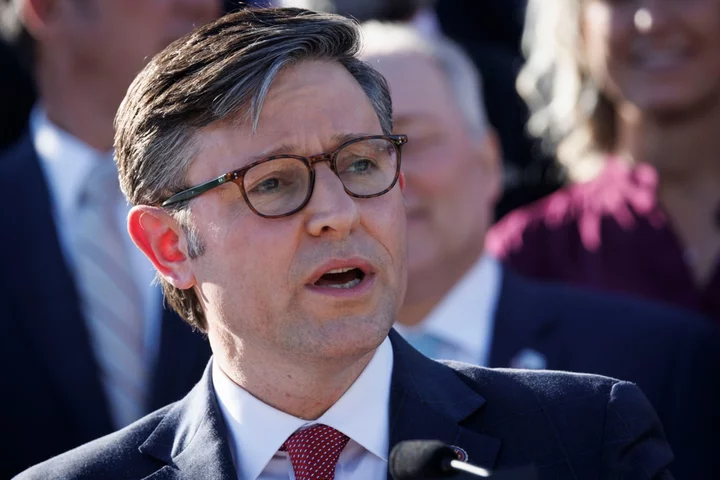The risk of a US government shutdown on Nov. 18 eased as House Speaker Mike Johnson proposed a compromise temporary funding plan without insisting on deep spending cuts that ultraconservatives have sought.
Johnson presented his proposal with less than a week to go before the current temporary spending bill runs out, leaving little time for Republicans and Democrats to work out differences and avoid a shutdown. But by refusing to impose the 30% immediate cut to spending and US asylum law changes demanded by some conservatives, Johnson improved the outlook for a compromise.
The proposal, which omits new funding for aid to Israel and Ukraine, would extend funding for some government agencies to January and others to February. While the two-step idea risks Democratic pushback, it is more likely to pass the Senate given its lack of immediate spending cuts.
“The bill will stop the absurd holiday-season omnibus tradition of massive, loaded up spending bills introduced right before the Christmas recess,” Johnson said in a statement.
An extension until Jan. 19 would apply to funding for the departments of Veterans Affairs, Energy, Agriculture, Transportation as well as Housing and Urban Development, with the rest extended to Feb. 2. The goal is to prod the Senate to speed up work on those bills.
Republican leaders plan a House vote on the plan Tuesday — which could end Johnson’s brief honeymoon period with conservative rebels in the party.
Hardline conservatives have demanded that Johnson attach immediate spending cuts and changes to US migration policies to any temporary funding to keep open the government. Johnson will almost certainly need Democrats to pass his plan through the House over these objections.
Read more: US’s Last Top Credit Rating Is Threatened in Shift by Moody’s
Former Speaker Kevin McCarthy was ousted in early October for allowing lawmakers to vote on the 48-day measure that funds the government now. That sparked three weeks of intra-party battles to choose a successor, culminating in the elevation of Louisiana’s Johnson, a darling of fiscal and social conservatives in the GOP.
Dairy, Submarine
Representative Chip Roy, a Texas Republican influential among ultra-conservatives on fiscal matters, denigrated the proposed strings-free temporary funding.
“It’s a 100% clean. And I 100% oppose,” Roy said on X, the platform formerly known as Twitter.
The bill extends some US farm subsidies, including for dairy products. It also contains a provision to allow the building of a second Columbia-class ballistic missile submarine, a program led by General Dynamics Corp.
The House Rules Committee will hold a hearing Monday to consider the bill, decide whether to advance it to a floor vote and to set procedures for that action.
Illustrating the stakes, Moody’s Investors Service on Friday lowered the US’s credit-rating outlook to negative from stable. Moody’s cited increasing risks to the country’s fiscal strength and specifically pointed to political polarization in Congress.
Johnson told lawmakers on a call Saturday that the plan avoids allowing the Senate to jam the House with a giant spending package just before the Christmas holiday in December, according to people familiar with the conversation. He also said it decouples the stopgap bill from the battles in Washington over further aid to Ukraine.
Johnson said that if the Senate fails to negotiate full-year funding bills, the House will focus on a full-year stopgap bill until Sept. 30, a move that would allow a 1% cut to all spending under an earlier debt-ceiling deal.
However, the GOP plans to spare defense in any full-year stopgap, a person familiar with the discussions said.
Divisions among Republicans over government spending already have forced Johnson to cancel votes on two annual spending bills during his brief time as speaker. A sustained revolt by conservatives could force him to back off Saturday’s plan, raising the risk of a shutdown anew.
The White House budget office this week began coordinating shutdown plans with federal agencies. If a shutdown happens, federal workers deemed non-essential would be furloughed while essential civilian and military employees would work without pay. Federal contracts would be delayed along with payments to vendors.
Goldman Sachs Group analysts estimated in September that a shutdown would reduce the US economy’s quarterly growth by 0.2 percentage points for every week it lasted.

